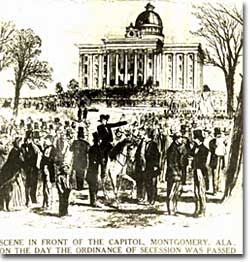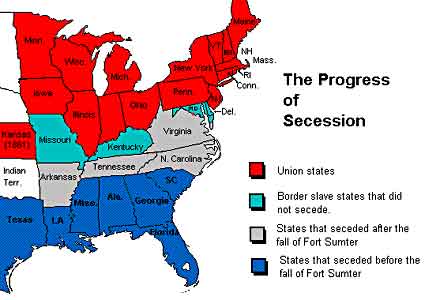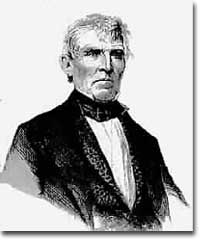32e. The South Secedes

Crowds gathered in front of the Capitol building in Montgomery, Alabama, the day that the secession bill was passed.
The force of events moved very quickly upon the election of Lincoln. South Carolina acted first, calling for a convention to secede from the Union. State by state, conventions were held, and the Confederacy was formed.
Within three months of Lincoln's election, seven states had seceded from the Union. Just as Springfield, Illinois celebrated the election of its favorite son to the Presidency on November 7, so did Charleston, South Carolina, which did not cast a single vote for him. It knew that the election meant the formation of a new nation. The Charleston Mercury said, "The tea has been thrown overboard, the revolution of 1860 has been initiated."
South Carolina Ordinance of Secession

This map shows the states that seceded from the Union before the fall of Fort Sumter, those that seceded afterwards, the slave states that did not secede, and the Union states.
Within a few days, the two United States Senators from South Carolina submitted their resignations. On December 20, 1860, by a vote of 169-0, the South Carolina legislature enacted an "ordinance" that "the union now subsisting between South Carolina and other States, under the name of 'The United States of America,' is hereby dissolved." As Gist had hoped, South Carolina's action resulted in conventions in other southern states. Mississippi, Florida, Alabama, Georgia, Louisiana, and Texas all left the Union by February 1. On February 4, delegates from all these states except Texas met in Montgomery, Alabama, to create and staff a government called the Confederate States of America. They elected President Jefferson Davis. The gauntlet was thrown. How would the North respond?

Senator Crittenden's two sons went on to serve as generals on opposite sides of the Civil War.
A few last ditch efforts were made to end the crisis through Constitutional amendment. Senator John Jordan Crittenden proposed to amend the Constitution to extend the old 36°30' line to the Pacific. All territory North of the line would be forever free, and all territory south of the line would receive federal protection for slavery. Republicans refused to support this measure.
On March 2, 1861, two days before Lincoln's inauguration, the 36th Congress passed the Corwin Amendment and submitted it to the states for ratification as an amendment to the Constitution. Senator William H. Seward of New York introduced the amendment in the Senate and Representative Thomas Corwin of Ohio introduced it in the House of Representatives. The text of the proposed amendment is as follows:
"No amendment shall be made to the Constitution which will authorize or give to Congress the power to abolish or interfere, within any State, with the domestic institutions thereof, including that of persons held to labor or service by the laws of said State."
Note that, much like the rest of the language in the Constitution prior to the Civil War, the proposed amendment never uses the word "slavery," instead employing the euphemisms "domestic institutions" and "persons held to labor or service." The proposed amendment was designed to reassure the seceding slave states that the federal government would not interfere with their "peculiar institution." If it had passed, it would have rendered unconstitutional any subsequent amendments restricting slavery, such as the 13th Amendment, which outlawed slavery throughout the nation. The Corwin Amendment passed the state legislatures in Ohio, Kentucky, Rhode Island and Maryland. Even Lincoln's own state of Illinois passed it, though the lawmakers who voted for it in Illinois were not actually the elected legislators but were delegates to a state constitutional convention.
Lincoln supported the Amendment, specifically mentioning it in his first inaugural address:
"I understand a proposed amendment to the Constitution — which amendment, however, I have not seen — has passed Congress, to the effect that the Federal Government shall never interfere with the domestic institutions of the States, including that of persons held to service ... holding such a provision to now be implied constitutional law, I have no objection to its being made express and irrevocable. "
The amendment failed to get the required approval of 3/4 of all state legislatures for a Constitutional Amendment, largely because many of the southern slave states had already seceded and did not vote on it.
What was the President doing during all this furor? Abraham Lincoln would not be inaugurated until March 4. James Buchanan presided over the exodus from the Union. Although he thought secession to be illegal, he found using the army in this case to be unconstitutional. Both regions awaited the arrival of President Lincoln and wondered anxiously what he would do.






